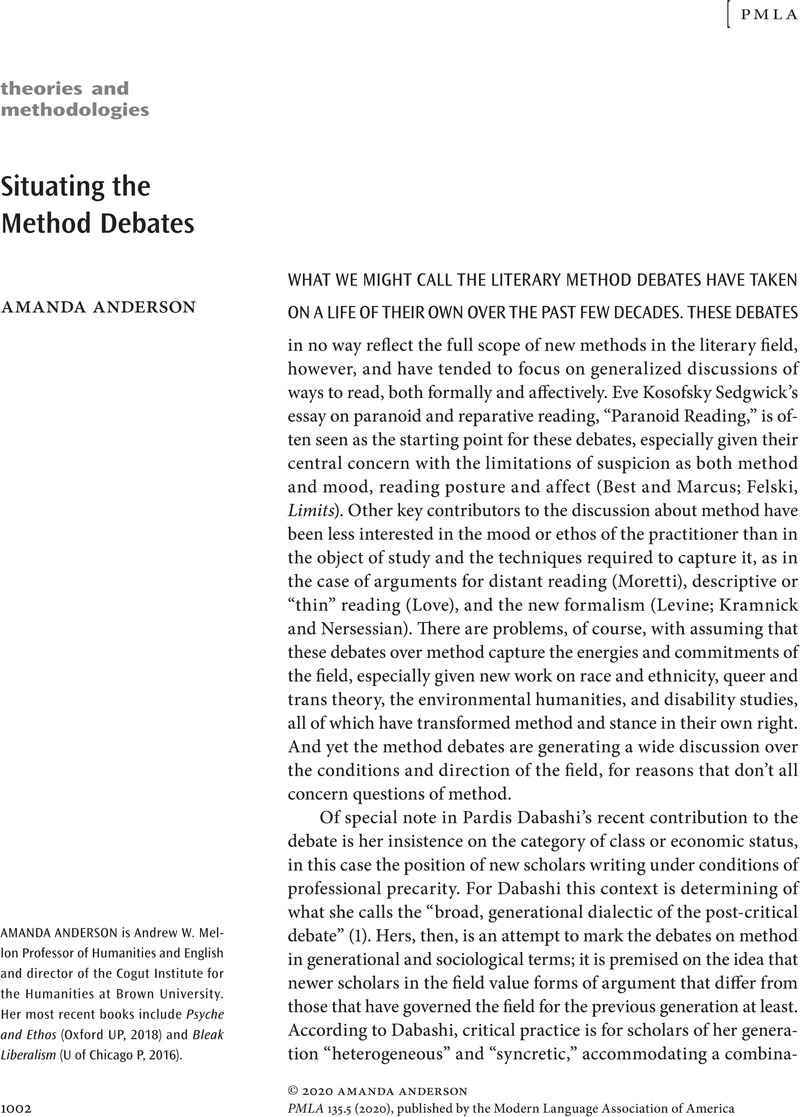No CrossRef data available.
Article contents
Situating the Method Debates
Published online by Cambridge University Press: 18 January 2021
Abstract
An abstract is not available for this content so a preview has been provided. Please use the Get access link above for information on how to access this content.

- Type
- Theories and Methodologies
- Information
- Copyright
- Copyright © 2020 Amanda Anderson
References
Works Cited
Anderson, Amanda. Psyche and Ethos: Moral Life after Psychology. Oxford UP, 2018.CrossRefGoogle Scholar
Anderson, Amanda. The Way We Argue Now: A Study in the Cultures of Theory. Princeton UP, 2006.Google Scholar
Anderson, Amanda. “The Way We Talk about the Way We Teach Now.” Profession, 2009, pp. 19–27.CrossRefGoogle Scholar
Best, Stephen, and Marcus, Sharon. “Surface Reading: An Introduction.” The Way We Read Now, special issues of Representations, edited by Best and Marcus, vol. 108, no. 1, Fall 2009, pp. 1–21.CrossRefGoogle Scholar
Clune, Michael. “The Humanities' Fear of Judgment.” The Chronicle of Higher Education, 26 Aug. 2019, www.chronicle.com/interactives/20190826-CluneJudgement.Google Scholar
Collins, Randall. The Sociology of Philosophies: A Global Theory of Intellectual Change. Harvard UP, 1998.Google Scholar
Dabashi, Pardis. “The Pressure to Intervene: A Case for the Modest (Young) Critic.” Post-critique and the Profession. MLA Annual Convention, 4 Jan. 2019, Hyatt Regency, Chicago.Google Scholar
Douthat, Ross. “The Academic Apocalypse.” The New York Times, 11 Jan. 2020, www.nytimes.com/2020/01/11/opinion/sunday/academics-humanities-literature-canon.html.Google Scholar
Endgame: Can Literary Studies Survive? The Chronicle of Higher Education, 2020, connect.chronicle.com/rs/931-EKA-218/images/ChronicleReview_Endgame.pdf.Google Scholar
Guillory, John. “The Sokal Affair and the History of Criticism.” Critical Inquiry. vol. 28, 2002, pp. 470–508.CrossRefGoogle Scholar
Kramnick, Jonathan, and Nersessian, Anahid. “Form and Explanation.” Critical Inquiry. vol. 43, 2017, pp. 650–59.CrossRefGoogle Scholar
Love, Heather. “Close but Not Deep: Literary Ethics and the Descriptive Turn.” New Literary History. vol. 41, no. 2, 2010, pp. 371–91.Google Scholar
Moretti, Franco. Graphs, Maps, Trees: Abstract Models for Literary History. Verso, 2007.Google Scholar
Newfield, Christopher. The Great Mistake: How We Wrecked Public Universities and How We Can Fix Them. Johns Hopkins UP, 2018.Google Scholar
Sedgwick, Eve Kosofsky. “Paranoid Reading and Reparative Reading; or, You're So Paranoid You Probably Think This Introduction Is about You.” Novel Gazing: Queer Readings in Fiction, edited by Sedgwick, , Duke UP, 1997, pp. 1–38.CrossRefGoogle Scholar
Sirinelli, Jean-François. “The Concept of an Intellectual Generation.” Intellectuals in Twentieth-Century France: Mandarins and Samurais, edited by Jennings, Jeremy, St. Martin's Press, 1993, pp. 82–93.CrossRefGoogle Scholar
Williams, Jeffrey J. “The New Modesty in Literary Criticism.” The Chronicle of Higher Education, 5 Jan. 2015, www.chronicle.com/article/The-New-Modesty-in-Literary/150993.Google Scholar


